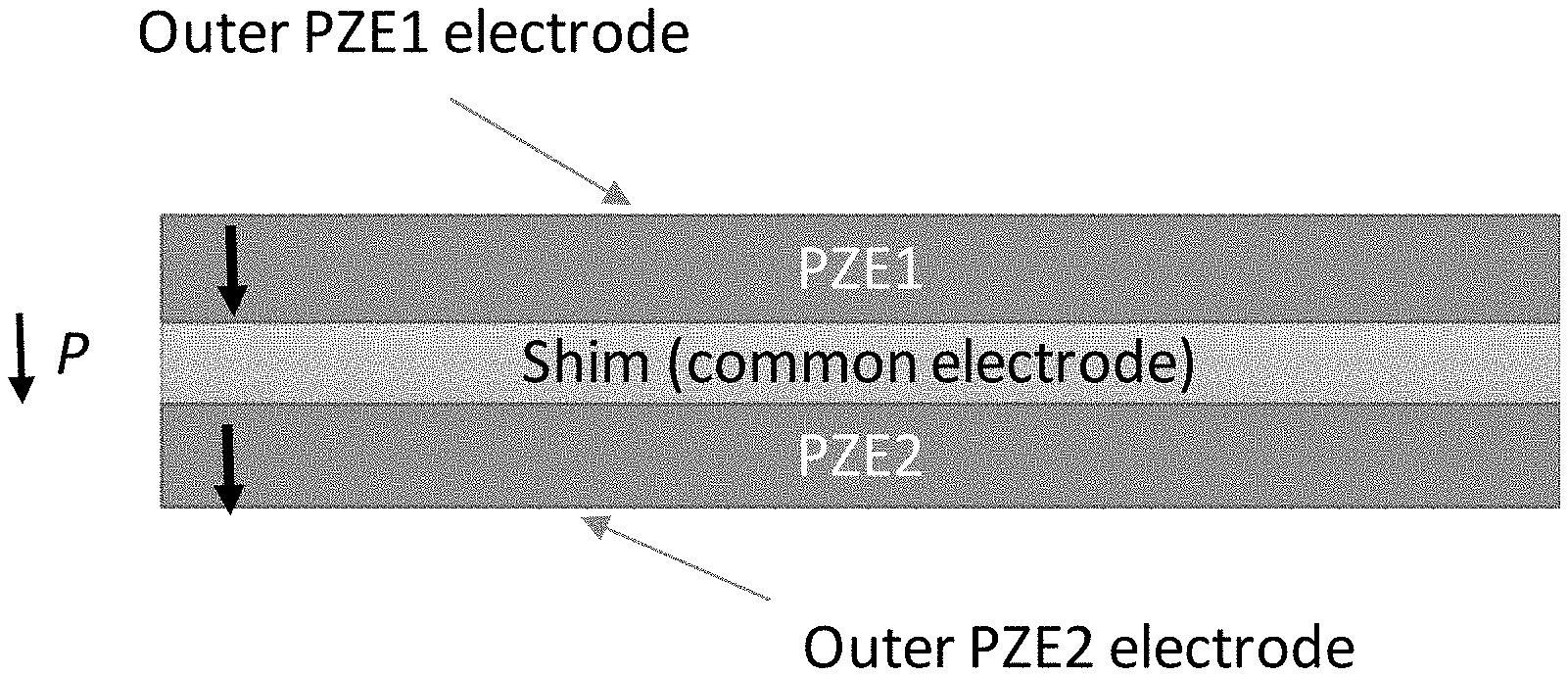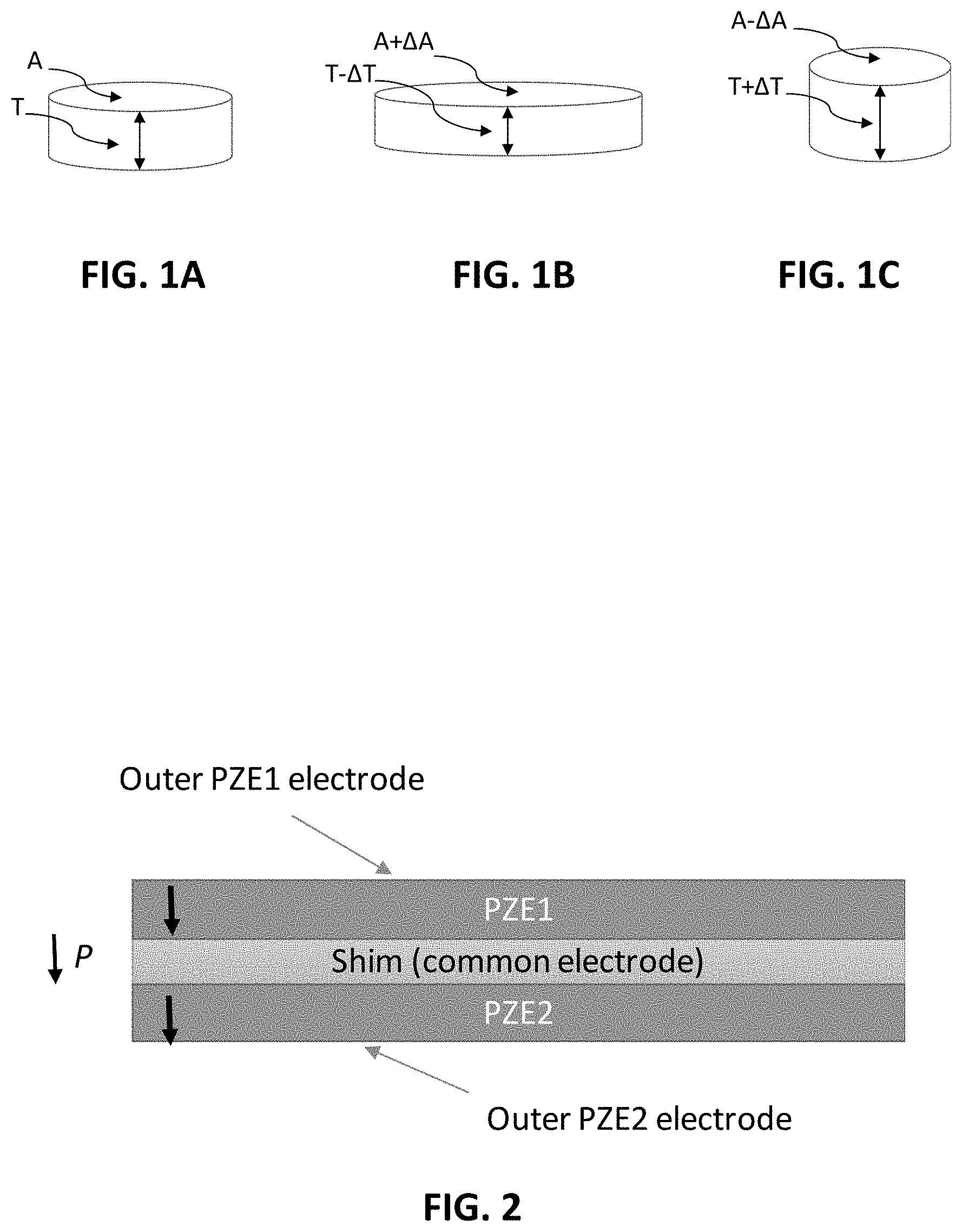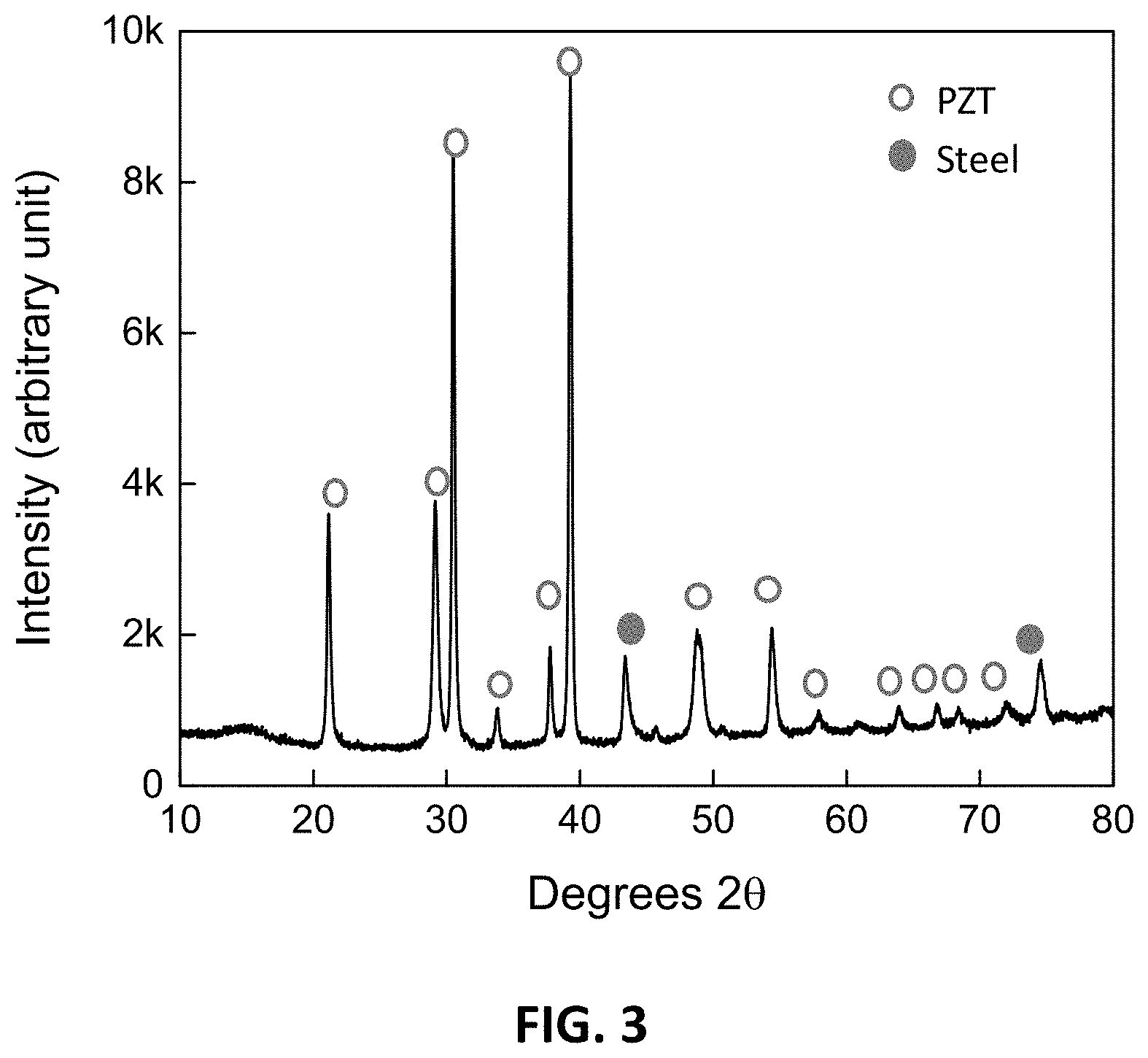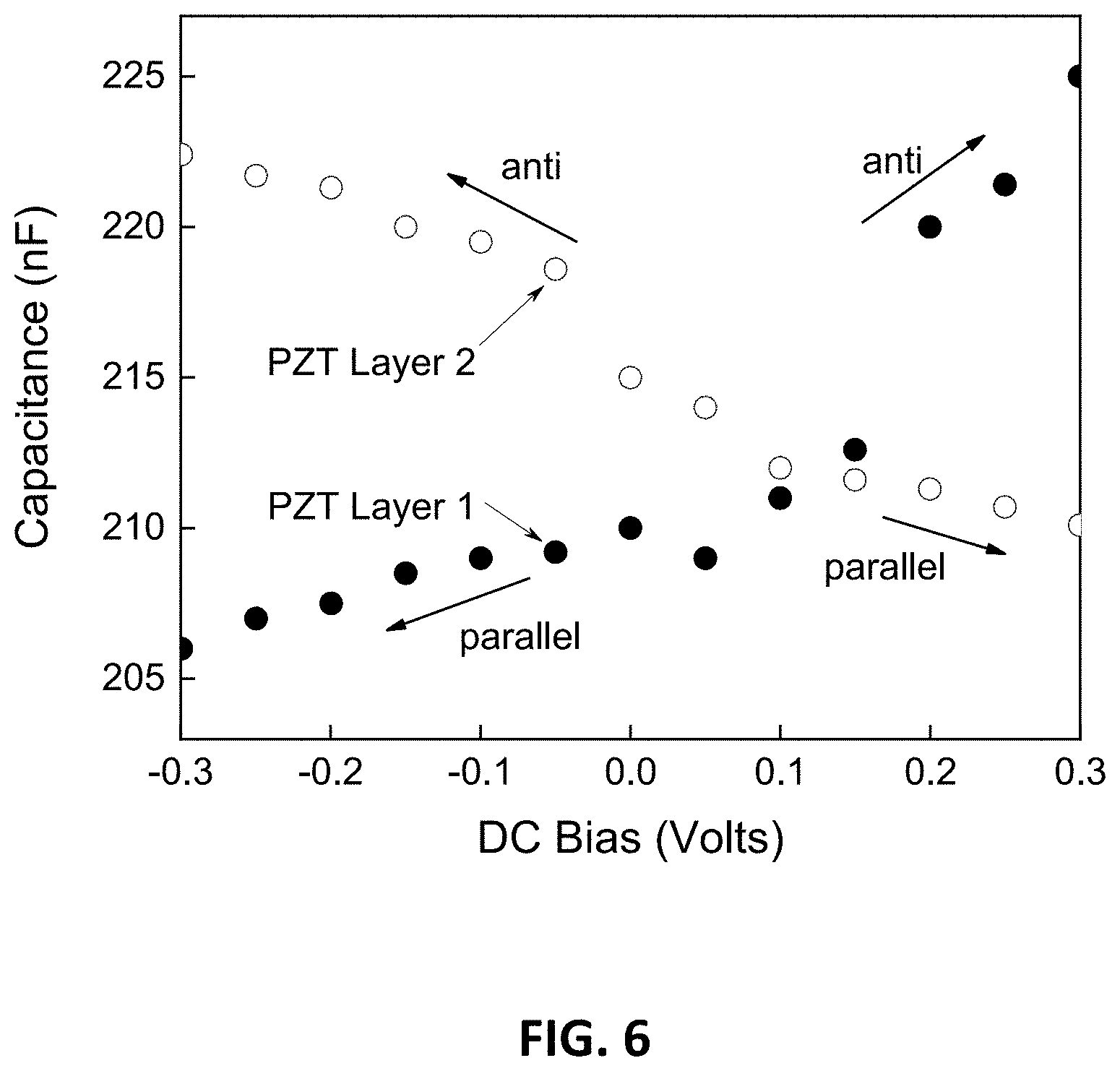Electrical Extraction of Piezoelectric Constants
Al Ahmad; Mahmoud F. Y.
U.S. patent application number 16/674515 was filed with the patent office on 2020-05-07 for electrical extraction of piezoelectric constants. The applicant listed for this patent is United Arab Emirates University. Invention is credited to Mahmoud F. Y. Al Ahmad.
| Application Number | 20200141990 16/674515 |
| Document ID | / |
| Family ID | 70459514 |
| Filed Date | 2020-05-07 |












View All Diagrams
| United States Patent Application | 20200141990 |
| Kind Code | A1 |
| Al Ahmad; Mahmoud F. Y. | May 7, 2020 |
Electrical Extraction of Piezoelectric Constants
Abstract
Activity of piezoelectric material dimension and electrical properties can be changed with an applied stress. These variations are translated to a change in capacitance of the structure. Use of capacitance-voltage measurements for the extraction of double piezoelectric thin film material deposited at the two faces of a flexible steel sheet is described. Piezoelectric thin film materials are deposited using RF sputtering techniques. Gamry analyzer references 3000 is used to collect the capacitance-voltage measurements from both layers. A developed algorithm extracts directly the piezoelectric coefficients knowing film thickness, applied voltage, and capacitance ratio. The capacitance ratio is the ratio between the capacitances of the film when the applied field in antiparallel and parallel to the polling field direction, respectively. Piezoelectric bulk ceramic is used for calibration and validation by comparing the result with the reported values from literature. Extracted values using the current approach match well values extracted by existing methods.
| Inventors: | Al Ahmad; Mahmoud F. Y.; (Al Ain, AE) | ||||||||||
| Applicant: |
|
||||||||||
|---|---|---|---|---|---|---|---|---|---|---|---|
| Family ID: | 70459514 | ||||||||||
| Appl. No.: | 16/674515 | ||||||||||
| Filed: | November 5, 2019 |
Related U.S. Patent Documents
| Application Number | Filing Date | Patent Number | ||
|---|---|---|---|---|
| 62755770 | Nov 5, 2018 | |||
| Current U.S. Class: | 1/1 |
| Current CPC Class: | H01L 41/22 20130101; G01N 27/22 20130101; G01R 29/22 20130101; G01R 27/2617 20130101 |
| International Class: | G01R 27/26 20060101 G01R027/26 |
Claims
1. A device configured for direct extraction of d.sub.33 and d.sub.31 from Cr-E.
2. A device configured for direct extraction of d.sub.33 and d.sub.31 from fr-E.
3. A method for direct extraction of d.sub.33 and d.sub.31 from Cr-E.
Description
CROSS-REFERENCE TO RELATED APPLICATION
[0001] This application claims the benefit of U.S. Provisional Application No. 62/755,770, filed on Nov. 5, 2018, which is incorporated herein by reference in its entirety.
BACKGROUND
[0002] Piezoelectric materials own special characteristics and properties that make them an excellent candidate to be utilized in advanced sensing fields. Such materials have been integrated and incorporated within highly adaptive smart structures. Flexible piezoelectric thin films have been implemented in biomedical applications due to their advantages of having highly piezoelectric constants, lightweight, slim, and biocompatible properties. Lead zirconate titanate (PZT) is a common piezoelectric material that is used for piezoelectric sensors and actuators. On the other hand, the monolithic integrated PZT wavers or patches, including ceramic materials, have poor fatigue resistance and are very fragile. That limits their ability to adapt to curved surfaces and makes them vulnerable to breakage accidentally through the bonding and handling procedures. This, in turn, affects the sensitivity of the sensor or actuator devices. The thin film technology finds further applications in such complicated conditions and curved surfaces. To overcome these issues, PZT was deposited on flexible sheets. The piezoelectric thin films on flexible sheets respond to nanoscale biomechanical vibrations caused by acoustic waves and tiny movements on corrugated surfaces of internal organs. Furthermore, it is used for developing self-powered energy harvesters, as well as sensitive nano-sensors for diagnostic systems. Flexible sheets of PZT material are naturally tough and pliable unlike the traditional piezoelectric patches. Xu et al. have developed a piezoelectric tape that is composed of patterned packed PZT elements sandwiched between two flexible metallic films. The PZT elements can have various distribution densities and shapes. They can be grouped or addressed individually. This phased array piezoelectric tape has good conformability to curved surfaces which makes it suitable to be used in different mechanical structures.
[0003] An apparent knowledge of material characteristics, including the piezoelectric coefficients and the electromechanical coupling factors is necessary for using the piezoelectric thin films in micromechanical systems (MMES). Uskokovie et al. has Compared the resulted piezoelectric coefficient values with other materials in other researches. Jackson et al. compared between capacitance-voltage (CV) method, laser doppler vibrometer (LDV), Berlincourt, and piezoelectric force microscopy (PFM) method to find piezoelectric properties of aluminum nitride (AlN). They concluded that LDV and PFM are the most accurate. In contrast, they reported that the CV method easiest and quickest method to use. Hemert et al. elaborated on the capacitance-voltage measurements and proposed a bias independent capacitance model as an alternative. They extracted from their proposed model d.sub.33 and k, then verified the results at various biased electrodes thicknesses. They have used bulk acoustic wave (BAW) resonator model as a bias dependent capacitance model for piezoelectric capacitors. Using this model, the piezoelectric coefficient d.sub.33 and dielectric constant were extracted from CV recording for three different layers thicknesses. On the other hand Hemert et al. criticized the CV method in other research as they concluded that the permittivity is not constant, so the piezoelectric parameters needs further information to be determined by the CV measurement such as the resonance measurements. Zhang et al. took AlN properties and studied the coefficients of AlN films by microscopy measurement and finite element method; they criticized the capacitance method due to the effect of interfacial capacitance between PZT films and electrodes as well as its low precision.
[0004] In previous research, Al Ahmad et al. have presented a new method of measuring piezoelectric thin film's vertical extension by utilizing the capacitance-voltage (CV) approach. This approach has received attention and several studies had commented and elaborated on its cons and pros. As a summary, many researchers have considered the reported CV method to be easiest and provides quick results; as it does not require sample preparations as in other competing methods, which makes it cheaper. In this paper, the piezoelectric coefficients have been extracted by a new algorithm using the CV method and applied to a proposed piezoelectric structure. The development of advanced piezoelectric structures that incorporate two piezoelectric layers sandwiching a flexible metallic sheet call for further optimization and enhancement of the current existing characterization methods. For an example, such structure can be inserted in a microfluidic channel to compare between two different pressures, each applied to a piezoelectric layer. The difference between the pressures (AP) can be translated into capacitance change (AC) in each layer.
BRIEF DESCRIPTION OF THE DRAWINGS
[0005] FIGS. 1A, 1B, and 1C shows illustration of piezoelectric materials response to applied electrical field: unbiased disk (FIG. 1A), anti-parallel (FIG. 1B), and parallel biasing schemes (FIG. 1C).
[0006] FIG. 2 shows illustration of double piezoelectric layers (PZE1 and PZE2) sandwiching a metallic sheet (Shim) with polling directions (.dwnarw.P).
[0007] FIG. 3 shows XRD measurements of the fabricated PZT layer.
[0008] FIG. 4 shows measured CV of bulk sample.
[0009] FIG. 5 shows capacitance versus frequency measurements for unbiased (at zero volts), anti (at +3 volt) and parallel biasing (at -3 volt).
[0010] FIG. 6 shows simultaneous CV measurements of the two piezoelectric layers.
[0011] FIG. 7 shows extracted piezoelectric voltage constants using (equation 12).
[0012] FIG. 8 shows polarization curve for the deposited film above steel sheet.
[0013] FIGS. 9A and 9B show extracted normalized capacitance ratio (Cr) values versus normalized applied electric field (E.sub.n) voltage along with their corresponding fitting curves: bulk sample used for calibration (FIG. 9A) and thin film under study (FIG. 9B).
DETAILED DESCRIPTION
[0014] This work investigates the use of CV characteristics to extract the piezoelectric voltage constants utilizing the change in capacitance. A new proposed structure composed of two piezoelectric layers is proposed and analyzed using the developed method. The following sections illustrate the approach of characterizing the piezoelectric material, the properties of the prepared sample, and the calibration technique to optimize the characterization algorithm.
Capacitive-Voltage Approach
[0015] When a piezoelectric material is sandwiched between two electrodes subjected to either mechanical or electrical strains, its geometrical dimensions and dielectric constant will change according to the direction and magnitude of the applied field. FIG. 1A illustrates a circular disk of a piezoelectric material without applying any type of field. When this disk is driven by applied electrical field with the direction opposite to the polling direction, the thickness decreases and the area increases simultaneously as depicted in FIG. 1B, resulting an increase in capacitance. On the other hand, if the applied electric field is aligned with the polling direction, the thickness increases and the area decreases simultaneously as depicted in FIG. 1C, resulting the decrease in capacitance. Mathematically, a parallel plate capacitance can be expressed as per equation (1), as follow:
C=.epsilon.A/T (1)
where: .epsilon., A and T are the dielectric constant, area, and thickness of piezoelectric layer sandwiched between the common and the outer electrode. The application of dc field opposite to the polled field will result in the contraction of the layer thickness and expansion in the area, hence the capacitance is expressed as per equation (2):
C.sub..dwnarw..uparw.=.epsilon.(A+.DELTA.A)(T-.DELTA.T).sup.-1 (2)
where .DELTA.A and .DELTA.T are the variation in area and thickness, respectively. Meanwhile, the application of dc field parallel to the polled field will result in the contraction of the layer area and expansion in the thickness, hence the capacitance is expressed as per equation (3):
C.sub..uparw..uparw.=.epsilon.(A-.DELTA.A)(T+.DELTA.T).sup.-1 (3)
Dividing (2) over (3), yields:
C.sub.r(T-.DELTA.T)(T+.DELTA.T).sup.-1=(A+.DELTA.A)(A-.DELTA.A).sup.-1 (4)
Where C.sub.r=C.sub..dwnarw..uparw./C.sub..uparw..uparw.. Equation (4) connects the change in capacitance ratio with the change in dimension due to the piezoelectric effect. With the help of (1+x).sup.n=1+nx, yields:
C.sub.r(1-2.DELTA.T/T)=(1+2.DELTA.A/A) (5)
Equation (5) correlate the changes in capacitance ratio to both changes in thickness and area.
[0016] It is worth to mention that the deposition process of both layers may end up with different thicknesses and dielectric constants, as they deposited sequentially. To overcome such discrepancies, the variation in areas, thicknesses, and dielectric constants is expressed in terms of applied electric field, rather than the applied voltage. By this, the geometrical variations and change in dielectric constants will be normalized. The variation in thickness and area in terms of applied electric field (E) can be expressed as follow:
.+-..DELTA.T/T=.+-.d.sub.33E (6)
.+-..DELTA.A/A=.+-.2d.sub.31E+(d.sub.31E).sup.2 (7)
Where d.sub.33 and d.sub.31 are the longitudinal and transversal piezoelectric voltage constants, respectively. As revealed from (6), the variation in thickness exhibits a linear relationship with the applied field, and from (7) the variation in area exhibits a quadratic relationship with the applied field. Substituting (6) and (7) into (5), produces:
C.sub.r-2C.sub.rd.sub.33E=1+4d.sub.31E+2(d.sub.31E).sup.2 (8)
Rearrange (8) for d.sub.31, assuming d.sub.33=2d.sub.31 yields:
2E.sup.2d.sub.31.sup.2+(4EC.sub.r+4E)d.sub.31+(1-C.sub.r)=0 (9)
Solving equation (9) for d.sub.31, yields:
d.sub.31=(-(C.sub.r+1).+-. {square root over (C.sub.r.sup.2+2.5C.sub.r+0.5))}E.sup.-1 (10)
[0017] Equation (10) states that there are two possible solutions, nevertheless, if the materials exhibit no piezoelectric effect, C.sub.r is equal to 1 and d.sub.31 is equal to zero. Hence the solution should read:
d.sub.31=(-(C.sub.r+1)+ {square root over (C.sub.r.sup.2+2.5C.sub.r+0.5))}E.sup.-1 (11)
[0018] The significant of (11) that it can solve for d.sub.31 without any required knowledge and information about the change in dielectric constant or any other variations. The only needed parameter is the thickness of the sputtered thin film. Hence for a given piezoelectric film, after the polling process, the capacitances are recorded corresponding to specific voltage value with negative and positive polarities. Then the electric field (E) and capacitance ratio (CO are computed. It is worth to mention that the assumed condition d.sub.33=2d.sub.31, can be replaced by more general one d.sub.33=xd.sub.31, where x can assume its values between 1 and 3. Furthermore, almost 95% of the published literature in PZT based piezoelectric materials has reported numerically values for d.sub.33 and d.sub.31; accordingly they can be approximated so that d.sub.33=2d.sub.31. Indeed, for the PZT based materials, the domain structure of the grains has a strong influence on this ratio (d.sub.33/d.sub.31).
Sample Preparation
[0019] To demonstrate the current approach, a thin piezoelectric film is deposited on both sides of steel sheet using the sputtering technique. The deposition conditions are listed in Table 1. The film post annealing process was done at 700.degree. C. for one hour. The thickness of the employed steel flexible sheet is of 50 .mu.m, and the thickness of the deposited piezoelectric layers on both steel sides was measured to be 2.41 .mu.m. FIG. 2 illustrates the stack composed of thin metallic steel sheet that coated from both sides with noble materials PLT/Pt/Ti as a seeding layer for the deposition of the piezoelectric thin film materials layers on both faces of the steel. As illustrated in FIG. 2, the shim layer is a flexible steel sheet which acts as a common electrode. Furthermore, both outer surfaces of PZE1 and PZE2 are coated with Al metallization to form electrical contacts. The films polling has been conducted at room temperature with the application of 250 kV/cm was applied for 20 minutes. The CV measurements are conducted between the metallic shim and the outer electrical electrodes.
[0020] As illustrated in FIG. 2, both layers have been polled in the same direction, hence for identically applied voltage polarities applied across them, their thicknesses will either both increases or decreases simultaneously. Meanwhile, if the applied voltages polarities are opposite to each other, one layer will increase in thickness and the other layer thickness will decrease.
[0021] To assess the efficiency of the fabrication process, the XRD measurements have been conducted for the steel flexible sheet before PZT deposition (blank) and for the flexible sheet with a PZT deposited over steel (coated). FIG. 3 represents the XRD measurements, the filled circle represents the diffraction peaks of steel flexible sheet, and the open circles represent the diffraction peaks of the PZT deposition layer on the flexible steel sheet. Clearly, that existence of multi peaks stimulates that the distribution of the peaks along the angle of orientation reveals that the PZT deposition quality is high and the sample does not have disordered materials.
TABLE-US-00001 TABLE 1 PZT thin film deposition conditions Ti Pt PLT PZT Deposition temp [.degree. C.] 500 500 650 700 Sputtering Pressure 0.8 0.5 0.5 0.5 [Pa] RF power [W] 80 100 150 90 Ar/O.sub.2 [sccm] 20/0 20/0 19.5/0.5 19.5/0.5 Deposition time [min] 6 8 15 300
Calibration Method
[0022] To further calibrate the proposed method, PZT unclamped bulk ceramic with thickness 0.24 mm has been utilized. The CV measurements are depicted in FIG. 4. The measured d.sub.31 using Berlincourt meter is of 250 .mu.m per volt of this unclamped sample. The extracted d.sub.31 piezoelectric voltage constant using (11) yields 190 .mu.m per volt. The current method is corrected by multiplying (11) with a factor (4/3), to correct the discrepancy between measured and extracted values; hence equation (11) is modified as per (12). Equation (12) incorporates the correction factor for calibration.
d.sub.31=(4/3)(-(C.sub.r+1)+ {square root over (C.sub.r.sup.2+2.5C.sub.r+0.5))}E.sup.-1 (12)
Results and Discussion
[0023] The electrical measurement was taken using the Gamry 3000 reference equipment. Capacitances versus frequency measurements (at zero bias) were conducted to determine the frequency range and its self-resonance frequency. The capacitance shows a smooth response over the frequency as displayed by FIG. 5. The measurements were taken along frequency variations in the range of 1-80 kHz. A dc voltage was applied to both layers for capacitance versus frequency at +3 volt dc bias (anti-polarization), and at -3 volt dc voltage bias (parallel to polarization).
[0024] FIG. 5 shows that when the applied voltage is anti-parallel to the poling direction of PZT material, the values of the measured capacitance increases with the frequency as it reaches around 230 nF. On the other hand, applying voltage parallel to the poling direction decreases the values of the measured capacitance slightly with the frequency and reaches around 75 nF. While in the zero biasing case, the capacitance measurements nearly stayed constant around the value 135 nF along the range of the frequency. As anticipated, the applied voltage in either parallel or opposite to poling direction will cause a change in the dimension which is pronounced by the capacitance measurements.
[0025] The two layers have been polled in opposite directions. FIG. 6 shows the two piezoelectric capacitance voltage responses when the applied voltage swept from -0.3 to +0.3 volts. For layer 1, the capacitance increase for the positive applied field as it is driven opposite to the polling field direction, meanwhile it decreases for the negative values as it is driven parallel to the to the polling field direction. On contrary, for layer 2, the capacitance increases for negative applied field as it is driven parallel to the polling field direction, meanwhile it decreases for positive values as it is driven opposite to the to the polling field direction.
[0026] With the help of (12) and the data presented in FIG. 5, the extracted d.sub.31 and d.sub.33 piezoelectric voltage constants have been estimated and depicted in FIG. 7. The applied electric field is of 1.25 volt per .mu.m. The constants exhibit a smooth behavior over the wide frequency range. At a frequency of 40 kHz, d.sub.33 and d.sub.31 constants read 284 and 142 .mu.m per volt, respectively. These values are comparable with reported values in the literature for same thin film thickness.
[0027] Equation (12) along with CV measurements presented in FIG. 6 have been used to extract the piezoelectric constants of both layer 1 and layer 2 of the stack shown in FIG. 2. The estimated mean values of values for d.sub.31 of layer 1 and 2 are 125 and 130 .mu.m per volt, respectively. Furthermore, the variation in the capacitance incorporating piezoelectric materials due to the applied voltage can be generated either by the dielectric constant voltage dependency and/or from the expansion/contraction in the dimensions of the poled material. FIG. 8 revealed that the change in the polarization due to the change in electric field is equal to 1.6 C/cm.sup.2. Hence the equivalent capacitance change from this change in polarization is of 0.6 pF. Therefore, 1% of the measured capacitance change is due to dielectric constant voltage dependency while 99% of this change is referred to the variations of sample dimensions due to the piezoelectric effect. The piezoelectric constant (e31,f) is then estimated to be -3.8 C/m.sup.2. The dielectric constant of the film is computed to be of 240 on average.
Direct extraction of d.sub.33 and d.sub.31 from Cr-E
[0028] It is also possible to extract simultaneously the d.sub.31 and d.sub.33 piezoelectric constants directly from (8). Equations (8) could be arranged to express the capacitance ratio (Cr) as a function of applied voltage (E), as per equation (13):
C.sub.r=(1+4d.sub.31E+2(d.sub.31E).sup.2)(1-2d.sub.33E).sup.-1 (13)
With the help of (1+x).sup.n=1+nx, yields:
C.sub.r=(1+4d.sub.31E+2(d.sub.31E).sup.2)(1+2d.sub.33E) (14)
Equation (14) could be further simplified as follow:
C.sub.r=1+2(d.sub.33+2d.sub.31)E+2(4d.sub.31d.sub.33+d.sub.31d.sub.31)E.- sup.2+4d.sub.31.sup.2d.sub.33E.sup.3 (15)
[0029] The last cubic term of (15) can be neglected, due its very small value; which yields:
C.sub.r=1+2(d.sub.33+2d.sub.31)E+2(4d.sub.31d.sub.33+d.sub.31d.sub.31)E.- sup.2 (16)
[0030] Equation (16) suggest that d.sub.31 and d.sub.33 can be extracted simultaneously by fitting the measured Cr values versus E; with the quadratic fitting. For calibration purposes, a piezoelectric bulk ceramic materials of thickness 0.150 mm with d.sub.33 and d.sub.31 of 430 and 230 .mu.m per volts, respectively, has been utilized. Nevertheless, as both the calibration sample and sample under test have different thicknesses of more than three order of magnitudes; it is suggested to use the normalized applied electric field to count for this difference. FIGS. 9A and 9B display the measured capacitance ratio versus the normalized applied field for the bulk and thin film samples, respectively. The fitting equation of the extracted capacitance ratio versus the normalized applied electric field for the bulk sample is found to be:
C.sub.r=1-0.04511E.sub.n-0.08492E.sub.n.sup.2 (17)
[0031] Comparing (17) with equation (16), the second and the third terms account for the piezoelectric effect. Hence:
2(d.sub.33+2d.sub.31)=-0.04511 (18)
2(4d.sub.31d.sub.33+d.sub.31d.sub.31)=-0.0849 (19)
[0032] Solving (18) and (19) simultaneously for d.sub.33 and d.sub.31 yields 0.0846 pC/N and 0.1666 pC/N, respectively. Hence for calibration the solution for (18) and (19) should be multiplied by a factor of 2700 to calibrate the method. Therefore the actual d.sub.33 and d.sub.31 reads 448 pC/N and 228 pC/N, respectively; i.e. d.sub.33 is equal 1.96 times d.sub.31 (approximately d.sub.33.apprxeq.2d.sub.31). For the film understudy; the corresponding fitting equation is found to be:
C.sub.r=0.95+0.06814E.sub.n-0.02134E.sub.n.sup.2 (20)
[0033] Solving (18) and (19) for (20), incorporating the calibration step yields d.sub.33 and d.sub.31 of 134 pC/N and 256 pC/N, respectively. The direct extraction using the Cr-E approach produces a maximum error of 5%.
Direct Extraction of d.sub.33 and d.sub.31 from Fr-E
[0034] Incorporating a piezoelectric material in a resonator structure that has a measurable resonance frequency, with the possibility to drive this resonator against and along polarization/polling directions, the resonance frequency is then can be written as:
f = 1 2 .pi. LC ( 17 - 1 ) ##EQU00001##
Where L is the effective inductor of the resonator, which will not change with driving the piezoelectric against or along the polling field. fr is the frequency ratio between the resonance frequency along the polarization over the resonance frequency measured when drive against the polling:
f r = 1 2 .pi. LC p / 1 2 .pi. LC a ( 18 - 1 ) ##EQU00002##
Yields:
[0035] f r = C a C p ( 19 - 1 ) ##EQU00003##
i.e.,
f.sub.r= {square root over (C.sub.r)} (20-1)
Hence
[0036] f r = AT ( 1 + .DELTA. A A ) ( 1 + .DELTA. T T ) ( 21 ) ##EQU00004##
Therefore
[0037] f rn = ( 1 + .DELTA. A A ) ( 1 + .DELTA. T T ) ( 22 ) ##EQU00005##
Which produces:
f.sub.rn=(1+2d.sub.31E+(d.sub.31E).sup.2)(1+d.sub.33E) (23)
And therefore
f.sub.n=1+(2d.sub.31+d.sub.33)E+(2d.sub.31d.sub.33+d.sub.31.sup.2)E.sup.- 2+d.sub.31.sup.2d.sub.33E.sup.3 (24)
Thus by fitting the frn versus applied E with cubic equation, the coefficient d31 and d33 can be extracted.
CONCLUSION
[0038] The characterization of piezoelectric constants relevant to a specific application will enhance their use. This work contributes to the development of an innovative methodology to determine the piezoelectric constants. The piezoelectric material should be incorporated as a capacitance dielectric materials. An electric applied field is then applied to drive the film parallel and anti-parallel to the polling field direction. This usually done by sweeping the voltage from negative to positive values. The variations in geometric dimensions and the corresponding dielectric constant of the materials due to the applied field will be reflected in the measured capacitance. The developed model requires only the pre-knowledge of the film thickness and automatically de-embed the change in dielectric constant due to the applied stress. The proposed method has been calibrated using unclamped bulk PZT ceramic and validated using conventional meters. The estimated and measured values are well corroborated with each other. The proposed technique does not require any sample heavy preparation steps, and provides a rapid response along with accurate estimation.
* * * * *
D00000

D00001

D00002

D00003

D00004

D00005

D00006

D00007

D00008






XML
uspto.report is an independent third-party trademark research tool that is not affiliated, endorsed, or sponsored by the United States Patent and Trademark Office (USPTO) or any other governmental organization. The information provided by uspto.report is based on publicly available data at the time of writing and is intended for informational purposes only.
While we strive to provide accurate and up-to-date information, we do not guarantee the accuracy, completeness, reliability, or suitability of the information displayed on this site. The use of this site is at your own risk. Any reliance you place on such information is therefore strictly at your own risk.
All official trademark data, including owner information, should be verified by visiting the official USPTO website at www.uspto.gov. This site is not intended to replace professional legal advice and should not be used as a substitute for consulting with a legal professional who is knowledgeable about trademark law.